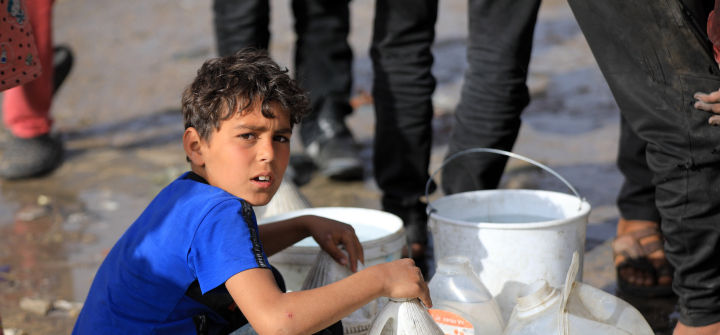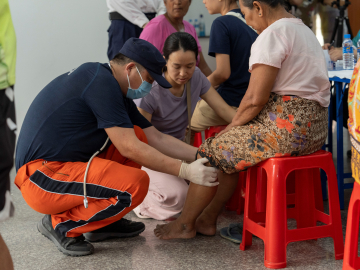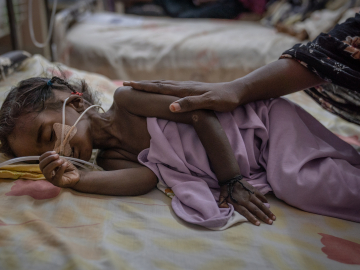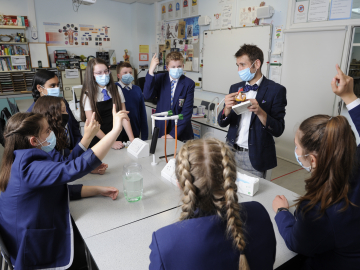What It Would Take to Achieve Water for Peace
Water for Peace, the theme of this year’s World Water Day, offers a dose of optimism that water can be leveraged as a peacebuilding tool in a year that has been rife with war.
Increasingly, it seems that water is a factor in many of these conflicts—from Gaza to Haiti to Ukraine. In some conflicts, tensions over access turn violent; in others, attacks on water resources are used as weapons of war. As president of the Pacific Institute, water expert Peter Gleick has worked to improve documentation of some of these atrocities and press for solutions. He spoke with GHN this week to mark World Water Day with an eye on how to tackle challenges including water poverty, access issues, and inadequately enforced water laws—and weighs in on where the public health community can help. In his new book, Three Ages of Water, Gleick offers a positive take: that all water problems are solvable if we embrace innovative opportunities, share information about them, scale them up, and push toward a more sustainable future.
Have we already reached the point of wars over access to water?
Wars start for a lot of reasons—for politics, ideology, economics, borders, religion; all sorts of things, so I don’t love the water wars framing. But it is true that we are seeing growing conflicts associated with water resources.
At the Pacific Institute, we maintain the Water Conflict Chronology—an open-source database looking at violence associated with water, going back more than 4,000 years—that looks at three categories. The first, water as a trigger of conflict, is the one most people think about—that is, access or control of water resources or disputes about water rights lead to conflict. In the second category, water disruptions are a casualty of conflict: Conflicts may start for whatever reason, but where water or water systems are targeted. And the third category is water as a weapon in conflicts that may start for other reasons, but where water systems are used as weapons. And we do see both an increase overall in the last couple of decades in the number of conflicts over water, and an increase in the number of conflicts where water is a trigger—where control of water, scarcity, [or] drought—lead to violent disputes over water resources.
Are we seeing a normalization of attacks on water infrastructure?
Russian attacks on Ukraine’s water systems are an example of a conflict that isn’t a water war, but where water systems and water infrastructure have been very intentionally targeted. Dams have been attacked; water treatment plants have been destroyed—it’s a good example of where attacks on civilian infrastructure can impact public health, by eroding access to safe water and sanitation and leading to an increase in water-related diseases. We’re seeing this in Gaza right now, too.
The destruction of water systems in Gaza has led to a big increase, according to the UN, in water-related diseases like cholera, dysentery, typhoid—because you need access to safe water to prevent these diseases.
How should the world react; how can this be deterred?
We know, for example, that attacking civilian infrastructure during conflicts is a violation of international humanitarian law. It’s a violation of the Geneva Conventions and the 1977 protocols on human rights. But the international community has not been good about enforcing those laws.
What is needed to improve enforcement of laws, or address the lack of legal recourse in some places?
Organizations on the ground could collect information about violations of international humanitarian law, attacks on civilian infrastructure, and help develop the evidence that could be taken to the international courts. And I think the international courts ought to be much more aggressive about enforcing the laws that are already on the books.
As long as countries get away with violations of international law, there’s little incentive to abide by them.
Has anyone ever brought a case focused on attacks on water infrastructure?
There has been one case in front of the International Criminal Court, against the former leader of Sudan, Omar al-Bashir—for a whole series of horrible violations of international law, but one [included] intentional attacks on water systems to further his political agenda. He’s never been arrested and brought to the court, but the cases have been filed. And the genocide case against Israel over the Gaza situation recently [brought to the International Court of Justice], does mention attacks on civilian infrastructure, including water and health and food infrastructure. But there ought to be a lot more of these cases—in Russia’s war in Ukraine, for example.
What are some examples of water access as a trigger for war?
Many water resources cross political boundaries and borders. Two or more countries share most of the world’s major rivers—and most do not have water sharing agreements. In the U.S., we have lots of rivers across state boundaries—but we also have institutions that allow us to resolve these disputes without going to war. Instead, we go to court. Those institutions aren’t perfect, but they reduce the risk of violent conflict. But many places don’t have that kind of legal system, and that’s part of the challenge.
What potential solutions do you see to water poverty and access challenges?
I’ve always felt that the biggest crisis that we face around water is the failure to provide safe water and sanitation for everyone and the associated public health problems that arise from that. There are two billion people or more who don’t have access to safe water and sanitation today and that leads to water related diseases and challenges for education for mostly women and girls. It’s a solvable problem, but we have not solved it.
We know droughts and floods are increasing because of climate change, and we’re not developing adequate strategies to deal with extreme weather conditions from a water perspective. When there’s a severe drought and you don’t have the institutions to deliver water equitably, the risk of conflict rises. Developing and proving those institutions, mechanisms, and strategies to share water equitably and to deal with drought is really important.
Where are the untold stories related to water and conflict specifically, the struggles that aren’t being covered enough?
For the last couple of decades, fights between farmers and pastoralists [livestock herders] in several Sahel countries—including Mali, Nigeria, and Burkina Faso—because water is scarce, borders are porous, and water and land rights are poorly defined. Some work has been done on that issue, but much more is needed. Also, on the border between Iran and Afghanistan, there’s a dispute over the Helmand River that has fueled violence. Within Iran itself, disputes between farmers and cities over water allocations have turned violent. India is seeing riots over the same thing. Conflicts can occur pretty much anywhere where institutions are weak, and where we’ve not prepared for these issues.
Where should the public health community focus attention to help solve these problems?
We’re working with a number of different groups and countries in different watersheds to try and expand the focus on solutions to provide safe water and sanitation to everyone, and to develop diplomatic and economic strategies to reduce violence over shared water resources. But much more needs to be done … starting with the strategies needed to meet the goal of [Sustainable Development Goal 6: to provide 100% of the world’s population with safe water and sanitation by 2030]. I don’t think we’re going to meet those targets by 2030.
We’re faced with a whole series of water crises, but all of them are solvable. We know how to provide safe water and sanitation to everyone. It’s not a technological problem; it’s not an economic problem. It’s an institutional problem. There needs to be a greater effort on the part of the medical community, communities in general, the corporate sector, and governments to meet the need. If we could provide safe water and sanitation for everyone on the planet, that would have an enormous positive impact on public health—but it would also have an enormous positive impact on reducing violence associated with the failure to ensure free access to those benefits.
Join the 50,000+ subscribers in 170+ countries who rely on Global Health NOW summaries and exclusive articles for the latest public health news. Sign up for our free weekday newsletter, and please share with friends and colleagues.
A Palestinian child waits in line for clean water in Rafah, Gaza, on March 16. Yasser Qudaih/Anadolu via Getty





